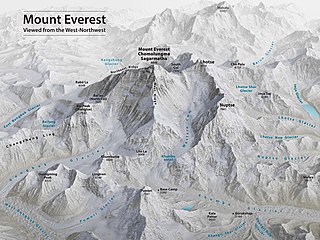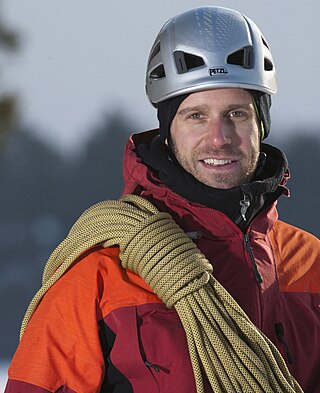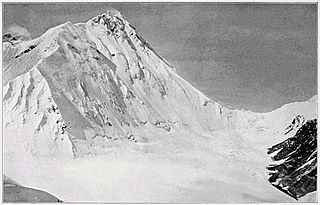Eric Simonson is an American mountain guide who has conducted many expeditions around the globe, including over 30 to the Himalayas. He organized the Mallory and Irvine Research Expedition in 1999 to attempt to resolve the mystery of the outcome of the 1924 British Mount Everest expedition and discovered the body of its lead climber George Mallory.

The Rongbuk Glacier is located in the Himalaya of southern Tibet. Two large tributary glaciers, the East Rongbuk Glacier and the West Rongbuk Glacier, flow into the main Rongbuk Glacier. It flows north and forms the Rongbuk Valley north of Mount Everest. The famous Rongbuk Monastery is located at the northern end of the Rongbuk valley. Mount Everest is the source of the Rongbuk Glacier and East Rongbuk Glacier.

George Herbert Leigh-Mallory was an English mountaineer who participated in the first three British Mount Everest expeditions from the early to mid-1920s.

Andrew Comyn "Sandy" Irvine was an English mountaineer who took part in the 1924 British Everest Expedition, the third British expedition to the world's highest mountain, Mount Everest.
The goal of the Mallory and Irvine Research Expedition of 1999 was to discover evidence of whether George Mallory and Andrew Irvine had been the first to summit Mount Everest in their attempt of 8–9 June 1924. The expedition was instigated by British climber Graham Hoyland. It was organised by regular Everest expedition leader Eric Simonson and advised by researcher Jochen Hemmleb, with a team of climbers from the United States, the United Kingdom, and Germany. Hemmleb's investigations of reports of earlier sightings and photographs had led him to identify what he believed was the area in which Irvine's body lay, some distance below where his ice axe had been found by Percy Wyn-Harris on the expedition led by Hugh Ruttledge in 1933. The team hoped in particular to find a camera on Irvine's body which, had the pair been successful, should have contained a picture of the summit. After commencing the search on 1 May 1999, Conrad Anker mistakenly got off course and, surprisingly, found Mallory's body, not Irvine's.

The Kangshung Face or East Face is the eastern-facing side of Mount Everest, one of the Tibetan sides of the mountain. It is 3,350 metres (11,000 ft) from its base on the Kangshung Glacier to the summit. It is a broad face, topped on the right by the upper Northeast Ridge, and on the left by the Southeast Ridge and the South Col. Most of the upper part of the face is composed of hanging glaciers, while the lower part consists of steep rock buttresses with couloirs between them. The steep southern third of the Kangshung Face also comprises the Northeastern Face of Lhotse; this section may be considered a separate face altogether following the division of the South "Neverest" Buttress up to the South Col. It is considered a dangerous route of ascent, compared to the standard North Col and South Col routes, and it is the most remote face of the mountain, with a longer approach.

Mount Everest is the world's highest mountain, with a peak at 8,849 metres (29,031.7 ft) above sea level. It is situated in the Himalayan range of Solukhumbu district, Nepal.

Conrad Anker is an American rock climber, mountaineer, and author. He was the team leader of The North Face climbing team for 26 years until 2018. In 1999, he located George Mallory's body on Everest as a member of a search team looking for the remains of the British climber. Anker had a heart attack in 2016 during an attempted ascent of Lunag Ri with David Lama. He was flown via helicopter to Kathmandu where he underwent emergent coronary angioplasty with a stent placed in his proximal left anterior descending artery. Afterwards he retired from high altitude mountaineering, but otherwise he continues his work. He lives in Bozeman, Montana.
The 2007 Altitude Everest expedition, led by the American climber Conrad Anker, arrived at Base Camp below the north face of Everest in May 2007 and retraced the last journey of British climber George Mallory who was lost during the 1924 British Mount Everest expedition.
Eureka! Tent Company is an American company that sells Eureka! Brand outdoor recreation products. The brand, part of outdoor recreation company Johnson Outdoors Inc., is headquartered in Binghamton, New York.

David Allen Hahn is an American mountaineer, ski patroller and journalist. In May 2013, he reached the summit of Mount Everest for the 15th time—at the time, this was the most summits for a non-Sherpa climber, according to Outside Magazine contributor and climber Alan Arnette. His record was surpassed by Kenton Cool in 2022. Among Hahn’s other notable accomplishments are his 39 summits of Vinson Massif, Antarctica’s highest mountain. He has reached the summit of Denali in Alaska, North America’s highest peak, 25 times over the course of 37 expeditions.

Fredrik Sträng is a Swedish mountaineer, adventurer and documentary film maker.

The 1924 British Mount Everest expedition was—after the 1922 British Mount Everest expedition—the 2nd expedition with the goal of achieving the first ascent of Mount Everest. After two summit attempts in which Edward Norton set a world altitude record of 8,572.8 metres (28,126 ft), the mountaineers George Mallory and Andrew "Sandy" Irvine disappeared on the third attempt. Their disappearance has given rise to the long-standing speculation of whether or not the pair might – under a narrow set of assumptions – have reached the summit. Mallory's body was found in 1999 at 8,156 metres (26,760 ft), but the resulting clues did not provide any conclusive evidence as to whether the summit was reached.

The 1922 British Mount Everest expedition was the first mountaineering expedition with the express aim of making the first ascent of Mount Everest. This was also the first expedition that attempted to climb Everest using bottled oxygen. The expedition attempted to climb Everest from the northern side out of Tibet. At the time, Everest could not be attempted from the south out of Nepal as the country was closed to Western foreigners.

The 1921 British Mount Everest reconnaissance expedition set off to explore how it might be possible to get to the vicinity of Mount Everest, to reconnoitre possible routes for ascending the mountain, and – if possible – make the first ascent of the highest mountain in the world. At that time Nepal was closed to foreigners, so any approach had to be from the north, through Tibet. A feasible route was discovered from the east up the Kharta Glacier and then crossing the Lhakpa La pass north east of Everest. It was then necessary to descend to the East Rongbuk Glacier before climbing again to Everest's North Col. However, although the North Col was reached, it was not possible to climb further before the expedition had to withdraw.

Lhagba La or Lhakpa La is a 6,849-metre (22,470 ft) col about 7 kilometres (4.3 mi) northeast of Mount Everest in the Tibet Autonomous Region.

The Lho La(Chinese: 洛拉山坳) is a col on the border between Nepal and Tibet north of the Western Cwm, near Mount Everest. It is at the lowest point of the West Ridge of the mountain at a height of 6,006 metres (19,705 ft). It is not exactly a Pass, but a part of Mt. Everest Range

Lingtren, 6,749 metres (22,142 ft), is a mountain in the Mahalangur Himal area of Himalaya, about 8 kilometres (5.0 mi) distant in a direct line from Mount Everest. It lies on the international border between Nepal and the Tibet Autonomous Region of China and it was first climbed in 1935. A mountain nearby to the west was originally named Lingtrennup but is now more commonly called Xi Lingchain.
Precipitated by unexpected permission from Tibet, the 1935 British Mount Everest reconnaissance expedition was planned at short notice as a preliminary to an attempt on the summit of Mount Everest in 1936. After exceptionally rancorous arguments involving the Mount Everest Committee in London, Eric Shipton was appointed leader following his successful trekking style of expedition to the Nanda Devi region in India in 1934.
The 1936 British Mount Everest expedition was a complete failure, and raised questions concerning the planning of such expeditions. This was Hugh Ruttledge's second expedition as leader. Heavy snows and an early monsoon forced their retreat on several occasions, and on the final attempt two climbers narrowly survived an avalanche. This was the first expedition in which climbers were able to carry portable radios.